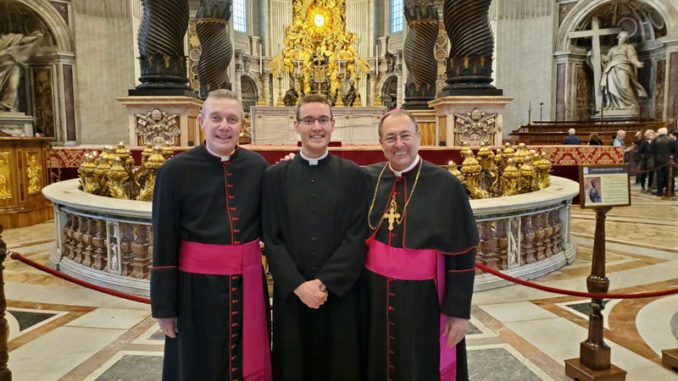
VATICAN CITY—The bishops of every diocese in the United States have been making detailed reports on the life of the Catholic Church, including Bishop Robert E. Guglielmone from the Diocese of Charleston, S.C.
The U.S. bishops’ visits “ad limina apostolorum” — to the threshold of the apostles — began Nov. 4, 2019, with a group from Massachusetts, Rhode Island, Connecticut, New Hampshire, Maine and Vermont.
Throughout November, December, January and February, another 14 groups of U.S. bishops travelled to Rome; with concluding visits planned through Feb. 22 with the bishops of the Eastern Catholic Churches in the United States.
The Southeastern bishops traveled to Rome from South Carolina, North Carolina, Florida and Georgia. Bishop Guglielmone will be back in his home diocese by Feb. 16, when he is scheduled to preside at Mass at the Basilica of St. Peter in Columbia.
The preparation of the reports and the scheduling of hourlong meetings at various offices of the Roman Curia can give the visits an appearance of being a business meeting.
But, as the “Directory for the ‘Ad Limina’ Visit” makes clear, the bishops’ visits are a pilgrimage with “a very definite purpose: that is, the strengthening of their own responsibility as successors of the Apostles and of their hierarchical communion with the Successor of Peter. The point of reference is a visit to the tombs of Sts. Peter and Paul, pastors and pillars of the Roman Church.”
At the heart of the bishops’ pilgrimage are Masses at the Rome basilicas of St. Peter, St. Paul Outside the Walls, St. John Lateran and St. Mary Major.
Bishop Guglielmone concelebrated Mass with his fellow bishops at the Basilica of St. John Lateran in Rome on Feb. 10, where Bishop Peter J. Jugis of Charlotte, N.C., was the principal celebrant and homilist.
As vicar general of the Diocese of Charleston, Msgr. Richard Harris traveled to Rome with Bishop Guglielmone to participate in the ad limina reporting on the diocese. Deacon Will Frei, who was ordained into the transitional diaconate in October 2019, is currently in Rome taking a two-year licentiate program in Ignatian Spirituality, and was able to visit with Bishop Guglielmone and Msgr. Harris.

For many bishops, the highlight is the meeting with the pope, but over the past 35 years, those meetings have changed significantly because of the increased number of bishops in the world.
Canon Law calls for the visits to occur every five years, but that hasn’t happened since early in the pontificate of St. John Paul II.
Just before Pope Benedict XVI stepped down in early 2013, the Vatican announced that it had taken seven years, but he had hosted the ad limina visits of the heads of every diocese in the world.
A couple hours later, though, the bishops of the Netherlands pointed out that they hadn’t had their visits with Pope Benedict. In the end, they had to wait until December 2013, when they were among the first bishops to have an ad limina with Pope Francis.
The U.S. bishops’ last ad limina visits were in 2011-12.
According to the latest statistics released by the Vatican, there are now 3,017 dioceses, prelatures and vicariates around the world. When St. John Paul II was elected in 1978 there were 2,423.
St. John Paul would meet privately with each and every head of a diocese during the ad limina visits; he would invite groups of them to his morning Mass; and he would give a speech to each group.
Midway through his pontificate, Pope Benedict adopted a modified format, meeting with 7-10 bishops at a time instead of having individual encounters. He also cut down on the number of speeches he gave — for example, giving formal addresses to only five of the 15 groups of U.S. bishops in 2011-12.
The format changes have continued under Pope Francis. His regular practice is to meet each group together — with sometimes 20 bishops sitting in a circle in the papal library — devoting between 90 minutes and two hours to a free-wheeling discussion.

